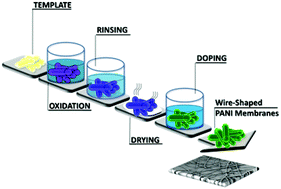Highly homogeneous core–sheath polyaniline nanofibers obtained by polymerisation on a wire-shaped template†
Abstract
Defect-free and highly homogeneous polyaniline (PANI)-Nylon 6 electrospun nanofibers are obtained through a solvent-induced segregation of N-phenyl-1,4-phenylenediamine (ADPA) on a fiber surface followed by an oxidative surface polymerization onto a wire-shaped template. Different oxidation salts are tested both as additives of the spinning solutions and in a polymerization bath. Comparison between mats obtained with a solvent induced segregation process and classical feed solution electrospinning is highlighted. As a result, self-standing emeraldine base PANI (EB) membranes are produced both in this pristine state and in a doped emeraldine salt state (ES). The doping process is carried out in different acid baths, namely hydrochloric acid, sulfuric acid and p-toluene sulphonic acid, the last being the most effective. Wire-shaped PANI membranes are characterized by scanning electron microscopy (SEM) and the polymerization/doping states of PANI are monitored step by step by UV-vis reflectance spectroscopy, infrared spectroscopy (FTIR) and contact angle measurements (CA).


 Please wait while we load your content...
Please wait while we load your content...